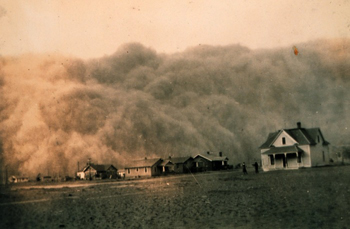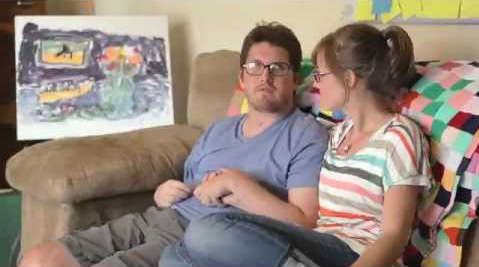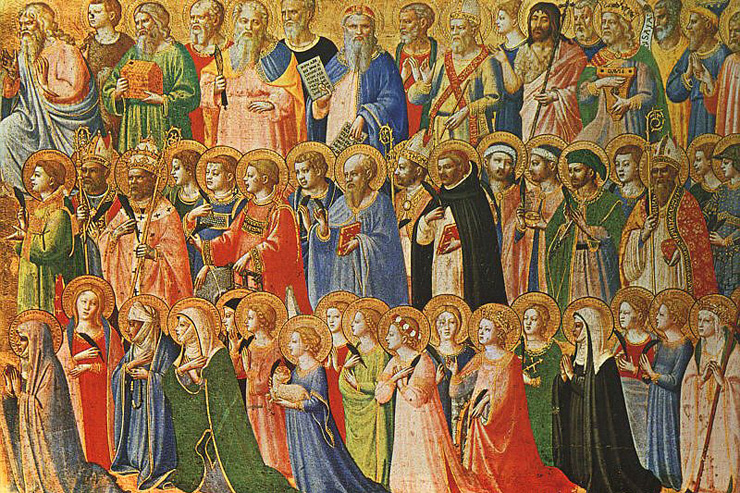 Many years ago, after mudslides in Pakistan killed hundreds of poor people, someone asked Mother Teresa why God would do such a thing to the poor? That disaster had mostly affected those living in shacks on hillsides. Mother Teresa replied, “Maybe they were closer to God and ready to die, while the rich need more time to prepare.”
Many years ago, after mudslides in Pakistan killed hundreds of poor people, someone asked Mother Teresa why God would do such a thing to the poor? That disaster had mostly affected those living in shacks on hillsides. Mother Teresa replied, “Maybe they were closer to God and ready to die, while the rich need more time to prepare.”
I loved how she turned the question upside down. Instead of treating disaster and death as a betrayal, Mother Teresa accepted death alongside life and saw God’s compassion.
After this past spring’s Southern tornadoes killed hundreds, the cataclysmic earthquake and tsunami in Japan and the historic flooding in my own back yard up and down the Missouri River, some wonder what God is doing. Chastisements? End Times? I’ve not received any memos so I won’t second-guess God on world management.
I’m no fan of suffering, but we all know that with every disaster comes heroism and rising above the ashes to become stronger. When I co-authored Amazing Grace for Survivors, we defined a survivor as one who “…is more than merely getting through an ordeal. It is being triumphant in spirit regardless of the outcome … Such challenges are the fire that does not merely test but purifies and empowers us.”
Disasters are birthplaces for survivors and heroes; places where people step beyond themselves to help others. I recently re-read my very favorite hero/disaster story as told in Children of the Dust Bowl: The True Story of the School at Weedpatch Camp by Jerry Stanley. As a homeschooler, the Dust Bowl years is a topic I stumbled upon while visiting a nursing home many years ago. My kids and I became friends with Adelaide, a lady in her nineties who raised her children in a corner of North Dakota that suffered through the decade-long drought. She lived day-by-day amid an ever-present film of dust. It was everywhere, even between their teeth and on their food. Adelaide’s stories sparked our interest so we watched several documentaries and read books about the Dust Bowl. The extent of the suffering astounded me because I had known so little about it. I’m assuming many people know very little about this decade-long disaster in American history.
The Dust Bowl Years
For the sake of those, like myself, who considered the Dust Bowl only a minor historical footnote, allow me to provide you the background.
Life had never been easy in the Oklahoma Panhandle; a stretch of rocky, red soil tucked between Texas, Kansas, and New Mexico. Small family farms with no irrigation systems survived on luck and prayers. In 1931, while our country was only beginning the decade-long Great Depression, it stopped raining on the Plains. Many were already reeling from the Stock Market Crash of 1929 and living on borrowed land. The crop prices dropped and the dry land shriveled everything that was planted in it.
The unrelenting wind took advantage of over-planted, dry soil and sucked it up into huge dust clouds. People would watch the sky darken as dust storms overtook the land. Windows and doors were plugged with tape and wet towels, but still the dust infiltrated homes and lungs to the extent that many died from dust pneumonia. People, unfortunate enough to get stranded outside when a storm hit, often suffocated to death.
By 1932, one thousand families a week lost their farms to the banks in Texas, Oklahoma, and Arkansas. It would seem that things could not get any worse, but it did. By 1936, no more than a few sprinklings of rain had fallen on the Panhandle for five years straight. The cruel wind began to blow on the Okies… day after day in unrelenting fashion. The sun was but a haze at best; cars, fences, and entire buildings were buried under deep drifts of dust.
The dust storms spread throughout the Great Plains, but the Oklahoma Panhandle was the epicenter. Many did not survive, but those that did began to realize that their best chance for survival was to get out.
California!
California became the Promised Land to the Okies who were penniless and broken from years of hardship. Blue skies, fertile soil and work were the promise to the Okies who loaded up their cars and jalopies for the long and treacherous drive west. Handbills from growers needing help with harvesting, enticed thousands to this land flowing with milk and honey.
It was a difficult trek across four states and nearly two thousand miles. Those who made it across Route 66 through the Tehachapi Mountains of California emerged through the San Joaquin Valley and rejoiced. As explained in Children of the Dust Bowl: “All of their troubles suddenly seemed to disappear for now they could see with their own eyes what they had only dreamed about for months, sometimes years. From two thousand feet above sea level, they saw a vast stretch of orchards, endless fields of grapes, cotton, and tomatoes, and as far as the eye could see in any direction, green – so much green it was hard to believe after life in the Panhandles.”
“It was paradise,” Trice Masters recalled. “When we saw the valley, we started hollerin’ and yellin’ ‘cause we knew it was Californ. We started singing’ and we didn’t care. If we ran out of gas, we’d make it ‘cause we could coast down.”
Ah, but the happy ending was not to be. Not yet. The Promised Land had overextended its promises. The growers in California, who had advertised for workers, were inundated. There was such a surplus that they could underpay field hands, knowing that people were desperate.
With no money and no work, Okies slept wherever they could in the open. In the midst of the fertile land of California, many of them starved to death. John Steinbeck was a journalist who visited the area at that time, and as a result, wrote The Grapes of Wrath to tell the story of what the Okies were living through… and dying from. Filth, starvation, and disease, including dysentery and malnutrition, siphoned the lives of so many who had made it so far.
Shunned and Taunted
In 1936, the Farm Security Administration began to build twelve camps in the San Joaquin Valley to provide emergency housing in tents and cardboard shacks. It provided little relief while the Okies vied for work to keep them alive. The public school system began “accepting” the Okie children, but that is far too gracious a word for what they did.
Without proper sanitation, adequate food or decent clothing, the Okies certainly made an impression – and it was not a good one. Add in their funny accents and educational deprivation, and some teachers were quoted as deeming those children uneducable. The Okies became untouchables at best and more commonly the brunt of cruel taunts and teasing.
While the Okies could finally breathe clean air, they could not breathe a sigh of relief for there was none. Adults and children alike were shouted at: “Okies go home!” Store windows had signs in them stating: “No Okies Allowed!”
Enter Leo Hart. At first, he seemed only to be a friendly man who came to the Weedpatch Camp to investigate and get to know the children. “He knew what we were goin’ though,” Joyce Foster recalled. “He knew they called us maggots and scum. He understood and he cared.”
In 1938, Leo was head counselor in the Kern County High school district. “Every day,” he recalled, “I talked to a dozen children who were crying because someone had called them a dumb Okie.” In 1939, he kept his compassion towards the Okies to himself while he ran for Kern Country superintendent of education. He was elected. His job would not be an easy one. Hostility towards the Okies was at a fever pitch. There had even been a mob headed by the sheriff that burned down another Okie migrant camp. The land had driven them from their homes and now people fueled by hatred and prejudice wanted to drive them out of California. As mistreated and unwanted as they were, they had nowhere else to go.
An Ingenious Solution
Leo had an idea. He presented the school board with a plan to remove the Okie children from the public schools by establishing an emergency school to relieve overcrowding. The board loved the idea of getting the hated Okies out of their schools but did not want to spend a dime on them. Leo promised to accomplish the Weedpatch School at no expense to the district.
In May of 1949, he leased a ten-acre site of land from the federal government for ten dollars. It was the field next to the camp. The school began with two condemned buildings that had been in the field for years and with fifty poorly clad, undernourished students. Leo began visiting universities and seeking out teachers with a passion for teaching. He warned them all that they would begin teaching at the most basic levels.
Then, Leo solicited donations for everything from lumber, building supplies and tools, to farm animals, books, typewriters and clothing. Teachers might teach history and math in the morning, and then teach construction “hands on” while the kids helped build their own school. Some teachers taught part of the day and then helped in the cafeteria. A teacher who taught chemistry, typing and stenography also showed the girls how to make their own face cream and soaps and taught hygiene.
Leo became a beggar of everything so that taxpayers could not complain about the Okie school. Donations began to pour in as dedicated, caring people caught the spirit. As the school evolved, lunches were made with food raised and grown at the school. Families took part in helping in the fields so that they too could be fed. Kids learned basic subjects but they were also trained in construction, agriculture, butchering, office tasks, and a myriad of skills where they learned and worked at the same time. One of the more unusual items used at the school was a C-46 aircraft bought for $200 from military surplus. Not only did the kids learn airplane mechanics on it, but anyone getting 90% or better in arithmetic, earned the privilege of driving it up and down a makeshift runway. The kids began to excel in math. Likewise, Leo directed students in the building of California’s first public swimming pool complete with a diving board and used it as incentive for good schoolwork.
Oh, the Irony!
 There were still occasional attacks of hatred, such as arson and dead animals dumped at the school, but the evolution of the Okies at Weedpatch School bordered on the miraculous. Gradually, the surrounding community caught wind of what was happening at the Okie school. Word spread that some of the best teachers in the country taught there and that the best chemistry equipment and best course in auto-mechanics was at the Okie school. Breakfast was sold for one cent and lunch for two cents with all the ingredients prepared, grown and raised at the school.
There were still occasional attacks of hatred, such as arson and dead animals dumped at the school, but the evolution of the Okies at Weedpatch School bordered on the miraculous. Gradually, the surrounding community caught wind of what was happening at the Okie school. Word spread that some of the best teachers in the country taught there and that the best chemistry equipment and best course in auto-mechanics was at the Okie school. Breakfast was sold for one cent and lunch for two cents with all the ingredients prepared, grown and raised at the school.
The school especially became known for its total lack of disciplinary problems. By 1944, irony of ironies, the previously hostile community of Kern Country clamored to get admitted into the Okie school.
Leo recalled, “The community that had threatened to drive the migrants out and who resented their presence came to accept them as part of the community when they saw what had been accomplished.”
The school that the Okie children had built from scratch ended in 1944. A legal ruling stated an emergency school could not last more than five years. It was absorbed by the nearby school district and renamed Sunset School. Non-migrant students enrolled by the hundreds, suddenly outnumbering the Okie children. It was no longer just their school, but they all had learned a valuable lesson.
Leo Hart and Weedpatch School is just one man and one story. I don’t know the whys behind every disaster, but I do know that tragedies present opportunities. We are all given moments in which we can become survivors and heroes. Maybe not always on a grand scale, but using Leo as an example, day-to-day actions don’t have to be so big to add up to something greater.
Like Blessed Teresa of Calcutta used to say, “We can do no great things, only small things with great love.”
Additional background information was gathered while viewing “The American Experience: Surviving the Dust Bowl” [VHS] (2005) – http://www.amazon.com/American-Experience-Surviving-Dust-Bowl/dp/B00000G0R2.
Please help us in our mission to assist readers to integrate their Catholic faith, family and work. Share this article with your family and friends via email and social media. We value your comments and encourage you to leave your thoughts below. Thank you! – The Editors













